HVAC Training Shop is reader-supported. As an Amazon Associate, I earn from qualifying purchases.
If you’ve ever looked at the return vents in different homes, you might notice that some of them have filters in them while others don’t.
Why is that?
Return vent filters are needed if there is no air filter in the HVAC unit. If there is an air filter in the HVAC unit, then return vent filters should not be used.
In this article, I’ll go over how return air vent filters work, and when they should be used. I’ll also cover the benefits of using return vent filters, and the differences between supply vent and return vent filters.
Should you use a filter in your return vent?
If your air handler does not have a filter rack in the unit, then you need to use a return vent filter.
If your air handler has a filter at the unit, then you do not need to use a return vent filter.
There are plenty of advantages of return vent filters. Here are some of them:
- The first line of defense – Return vent filters work as the first guard—preventing impurities from circulating in the air in your home.
- Easy to switch out – Due to its location, it’s usually easier to change out a return vent filter than the filter at your air handler. For example, if your home’s air handler is in the attic, you won’t need to crawl up there every time you need to swap out an air filter.
- Protection for ductwork – Return vent filters prevent particulates such as dust and hair from ever entering your HVAC ductwork. Notice dust building up in your ducts? The easiest way to get rid of this problem is to use a return vent filter.
- Promotes airflow circulation – If your home has multiple return vents, your air handler will have better airflow by using an air filter in each return vent versus a single filter at the air handler. This is because the filtration medium is spread out over a larger surface area, so your air handler will see less pressure drop and more airflow.
What if there is already a filter in your HVAC unit?
If you already have an air filter in your HVAC unit, then you do not need a return vent filter. You should only use an air filter in the HVAC unit OR the return vent, not both.
Why can’t you use a filter in your return vent AND your HVAC unit?
It’s all about airflow.
If you use an air filter in your return vent AND in your HVAC unit, then you run the risk of having low airflow issues.
Central air systems aren’t designed to run with the pressure drop from multiple air filters in series. So if you put filters in your return vent AND your HVAC unit, then your unit might start having issues.
Here is a diagram showing the locations of an air filter at the HVAC unit and return vent:
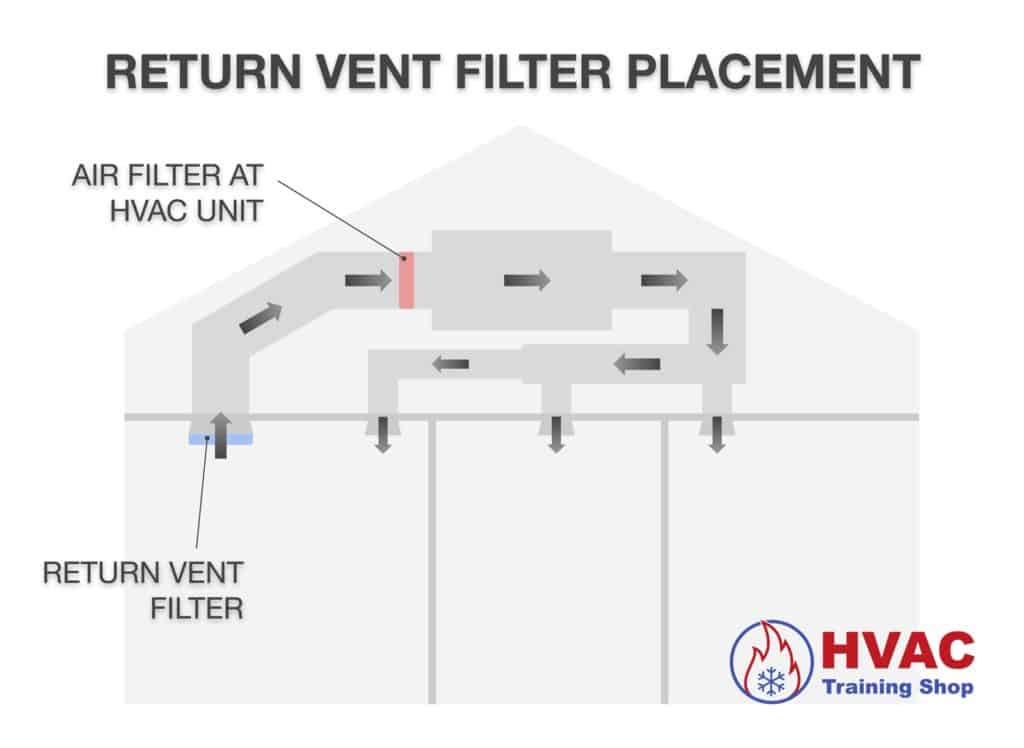
What if there is no air filter in your HVAC unit?
If there is no air filter in your HVAC unit, then you absolutely need a return vent filter.
I recommend using a MERV-5 to MERV-8 pleated air filter in your return vent.
In this case, the return vent filter will be the primary air filter. So it will serve as the only line of defense against dust and particles entering your HVAC system.
With a MERV 8 rating and mesh-reinforced construction, these filters block most household particles. Since they come in almost any size, these are my favorite pleated air filters to use.
How do return air vent filters work?
Return air vent filters work by filtering out particles and impurities from the air in your home. As the air gets sucked into your return vent, the return vent filter blocks out dust and particles from entering the airstream to your HVAC unit.
Return air vent filters are sometimes preferred over using a filter in the HVAC unit for these reasons:
- Filters in return vents prevent dust from getting in your ductwork.
- Homes with multiple return vents can accommodate multiple filters—allowing for more airflow through your HVAC unit since filtration is dispersed over a larger surface area.
If you have a rectangular return vent in your home, it can use a regular, rectangular-shaped air filter.
I’ll talk about return vent filter sizing below.
How to find your return vent filter size
Return vents come in many different sizes. Depending on the size of your return vent, you may need a certain size air filter. The size of your air filter can be determined by looking at the old air filter.
If the old air filter isn’t available, then you’ll need three different measurements: length, width, and depth. They can be measured by opening the return vent and measuring the sides:
- Measure the short side. For example, the short side could be 15-1/2″
- Measure the long size. For example, the long side could be 24-1/2″
- Measure the depth. For example, the depth could be 7/8″
- Round up the measurement. The size of the filter that you need to order would be 16″x25″x1″
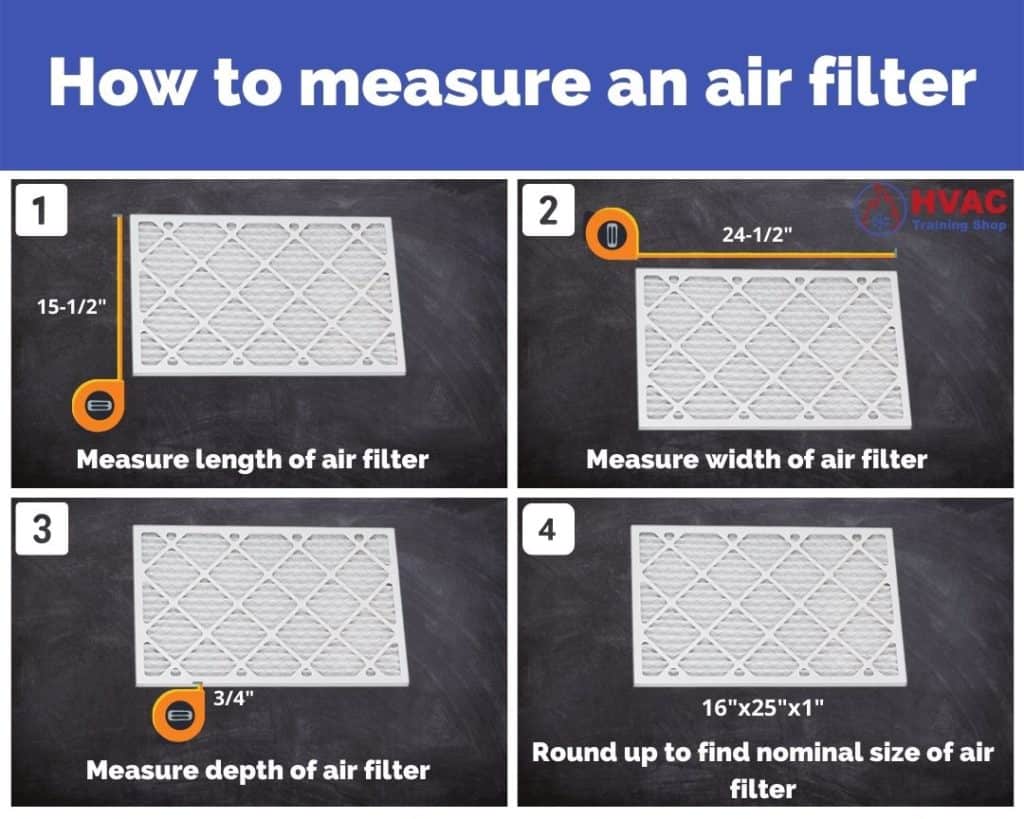
How to install a return vent filter
Here’s a quick tutorial for installing a return vent filter:
- Turn off the furnace or air handler. The first thing that you need to do when installing a new return vent filter is turn off your furnace or air handler. This is an important step because you don’t want your air handler to accidentally suck up dust from your old air filter when removing it.
- Open the return vent. To gain access to your return vent filter, unlock the hatch and open the screen. Most screens have hinges on one side of them, so it will flip open like a lid on a trash can. However, some screens come completely off—so be careful.
- Remove the air filter. As you open the return vent, the dirty air filter may fall out of its slot—so be prepared and keep one hand free to hold on to the air filter so it doesn’t slip out.
- Dispose of the dirty air filter. After removing the dirty air filter, throw it away. I like to keep an empty trash bag nearby to put the old dirty air filter inside right after removing it. Another thing to watch out for is dust build-up on the dirty air filter—be careful not to knock off the built-up dust from the dirty side of the air filter.
- Install the new air filter. When installing the new air filter, keep the filter direction in mind. The arrow on the side of the air filter should point toward the wall or ceiling. After putting the new air filter in its slot, close the return vent screen and lock it shut.
- Turn the furnace or air handler back on. When turning the air handler back on, you might notice the air filter move slightly towards the vent—that’s completely normal.
What if your return vent is an odd shape?
If your return vent is an odd shape or you can’t find a filter that will fit your vent, you can use a cut-to-fit air filter.
A cut-to-fit air filter comes in a roll of material that you can cut to conform to the shape of your air vent.
Cut-to-fit air filters usually come with velcro strips to hold them to your vent. By using velcro strips, your filters will remain in place until you’re ready to take them down for replacement.
For more information about cut-to-fit air filters, check out my article below:
This 30"x60" cut-to-fit air filter material can be cut down to the size and shape of your return grille. Perfect for use on odd-shaped or odd-sized return vents.
Supply vent filters versus return vent filters
What are the differences between supply and return vent filters?
- Supply vent filters are used to prevent particles from blowing out of your HVAC system.
- Return vent filters prevent particles from entering your HVAC system in the first place.
If you are having air quality issues, then supply vent filters will just mask the problem without actually making it go away.
If there is dust blowing out of your supply vent, then there is a bigger issue with your system:
- Your system might have an air leak, and dirty air is leaking into your return duct from your garage or attic.
- Your HVAC system (particularly your ductwork) might be very dirty and require a thorough cleaning.
Return vent filters help filter out contaminants from ever entering your system in the first place.
A return vent filter will keep your air handler, ducts, and coils clean by filtering out particulates at the point of air intake.
For some homeowners, a return vent filter could be the solution that keeps their HVAC system running cleanly and efficiently.

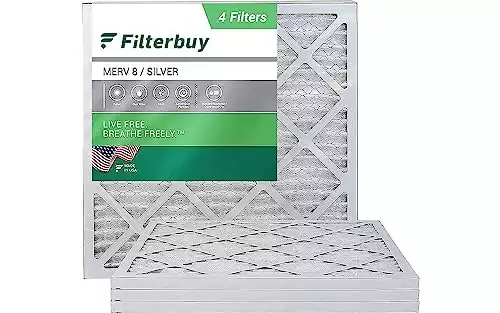
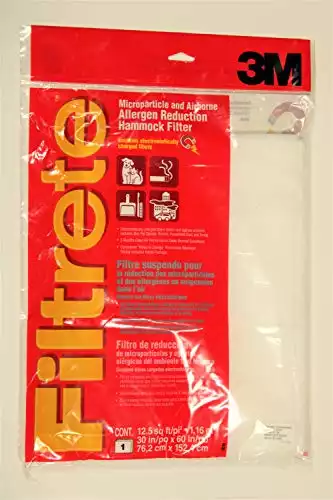
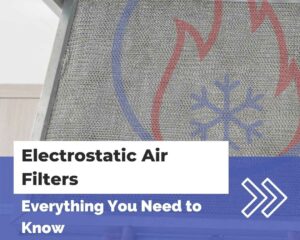
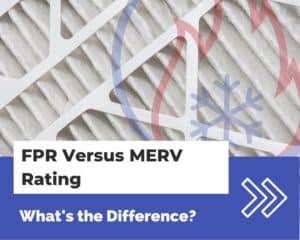
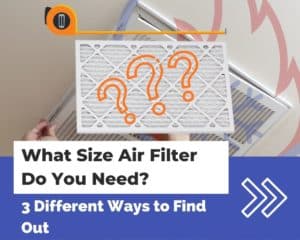
Does the metal in the filters damage the bearings in the hvac system?
Hi Darlene,
As long as the filter doesn’t collapse, it won’t cause any direct damage to your HVAC system.
Just remember to change your filter often so it doesn’t get plugged up. I recommend every 1-2 months.
Hope this helps,
-Trey
I noticed last night that when the HVAC system turned on, based on our thermostat settings, air was blowing out of the return duct (not warm) while warm air was indeed blowing out of the registers in the home rooms. The air filter was inserted correctly, with the arrows pointing inwards since this is the return duct. I have been using MERV 13 filters and I see that I should use MERV 8 ones. But would the higher MERV filter lead to our heating unit blowing any air out of the return duct? Airflow should only be into the return duct and not outwards, correct?
Hi Mitchell,
You are correct – airflow should only be into the return vents. A higher MERV rated filter shouldn’t make air blow out of your return vents.
Hope this helps,
-Trey
Hello! We just bought a new construction home and our HVAC has a filter on it in the attic. However, I have noticed an abnormal amount of dust even just a week after dusting. I can scoop it with my hand! We have two return air ducts. I know you said we should not need to put a filter in the returns, but *can* we without damaging the system?
Hi EB,
You should be fine with a filter on your return vent for a few days while you finish dusting your home. I would not leave the extra filter on the return vent for long periods of time, though.
I would expect your filter at the HVAC unit in the attic to stop collecting so much dust once you’ve had a chance to settle into your new home.
Hope this helps,
-Trey
I live in an older house, circa 1911 with an HVAC system that has large, metal registers in the floor, including the return duct. Dirt and dust often fall into these metal boxes and into the ducts themselves (when falling into the return vent they then travel to the unit itself.) The unit always has a 4″ pleated filter in it which has a minimum rating of MERV 11.
I was wondering if there is any type of non-airflow-restricting filter that can be put into some of these vents, even maybe just the return vent, to prevent debris from falling in, or is it best just to let the system work and vacuum it out every few months?
Hi Brian,
I would err on the side of caution when installing additional filters in your system. Any additional filter will add airflow restriction to your system and may cause problems in the long run.
-Trey
Hi Trey, Very cool site with a great deal of help. Thanks.
I have 6 separate return air sites all with Merv 8 filters (960sq.in. total)
My AC unit also has a space for a 20’X23′ filter (460sq.in) but I don’t have a filter in it. When I bought the house there was only the main AC filter (20″X23″) but I thought I’d give it more filter surface, plus keep the returns cleaner by swapping it each return having its own filter.
I change them all every 2 months even though they are still clean. I noticed that they cause a fair amount of resistance to the return air because they bow in the middle some. I’m worried that I’m causing a vacuum on all the return air ducts because of this. I have two large fiberboard air boxes in the attic, and there are large flexible tubes coming out from them going to the various return air vents.
I don’t want to use the 1″ 20″X23″ main AC filter even though any filter resistance there would only be a few inches between the blower and the filter and would not cause my other ducts to run in a partial vacuum.
I think what I’d like to do is install a large 19″ X 20″ X 5″ rack and air filter in the large return air plenum next to the air handler. Any vacuum would now be only felt in that short distance between the filter and blower and would be within the fiberboard plenum instead of the flexible tubing in the attic.
My AC sits on a wooden enclosure (its bottom fed) and the plenum comes straight down from the ceiling to the top of the wooden box.
So, what do you think of my concerns (partial vacuum) and what type of filter holder /rack would I use after I cut out horizontal space in the vertical fiberboard plenum?
Hi George,
Why are you concerned about a partial vacuum in your ducts? A slight negative pressure shouldn’t affect much. And since you have more filter surface area you should be getting more airflow than just using a single filter at your air handler.
Using a media filter at your air handler is the way to go if you want to eliminate the filters in your return vents. You probably should consult with a local HVAC company before doing the installation just to make sure that the media filter rack is sized correctly.
Hope this helps,
-Trey
Thanks for the reply Trey.
My concern about creating a slight vacuum in the returns was that if there were any bad connections or leaks, I would be sucking in very hot (Florida) attic air and causing the AC to work harder. I don’t know that there are any leaks and there isn’t enough room in the attic to check, so it was more of just an insurance policy.
Hi George,
If your vents are leaking, you would still be pulling in some attic air even if you use a filter at the unit, just a bit less so.
I’ve had my duct work cleaned & still having a lot of dust. One return vent that is wooden made below the floor from 1964 is collecting dust etc all inside of it again. Lived here over 30 years & I’ve noticed dust has been worse in the last 4 years. I change filter every 30 days & use MERV 8 or above. Any suggestions?
Since your duct is so old I’m wondering if there is a crack or hole somewhere in there that’s allowing dirty air to seep in.
-Trey
Trey: The air return on my heat pump system is in the floor. The system has a medical-grade filter in the crawl space near the coil and backup furnace. Unfortunately the air return acts as a vacuum cleaner and sucks in all kinds of hair, which requires me to frequently clean the medical-grade filter. Seems like a pre-filter in the in-floor grate would solve the problem, but restricting air is a issue. Is there a pre-filter I could use in the on-floor return to block hair that minimally restricts air.
Hi Sheldon,
Yeah, if your floor vent is a standard size, the fiberglass filters that are sold at most stores should do the trick. They don’t restrict much air and pretty much only capture larger dust and hair particles.
If your floor vent is not a standard size, then you can use cut-to-fit filter material to put in your vent. I’ve written an article on cut-to-fit air filters here: https://hvactrainingshop.com/cut-to-fit-air-filters/
Hope this helps,
-Trey
Hi Trey. Thanks for a great article. We use a 20x20x5 MERV 12 filter in the air handler (filter location is in the attic; air handler is on high shelf area in laundry room). We also have one 20×30 air intake vent in the hallway. I had not been installing any air filter at that location. But, after recently having our ducts cleaned, I noticed that the very large duct inside the air intake was literally covered with thick dust. I was told to use a very cheap, thin, maybe 1″ filter in that location to prevent future dust build-up. I purchased one without a frame. After turning the a/c back on, it immediately blew up – toward the duct – and off the lip. I then purchased a 1″ filter with a cardboard frame. Same thing. I even tried duct taping the edges and it still blows up and toward the duct. How can I prevent all the dust build-up if none of the filters will stay in place? Thanks for any suggestions.
Hi Nancy,
The velocity of the return air is causing the filter to get sucked into the return. Replacing the return vent with a “fixed bar” grille removes airflow restriction (and thus reduces velocity) compared to the standard “stamped face” grilles found in a lot of homes.
Other than that, the return vent itself would need to be sized up to reduce air velocity.
Hope this helps,
-Trey
When I had a new Trane inside and outside unit put in in 2019 the paperwork said that there would be a 4 in filter in the attic but when they were finished they told me that I would just have to change the filter on the Return vent so I have been changing it monthly. I just had another unit put in another house I own and the 4 inch filter is on the HVAC. Don’t know why they did not install it on my home unit so was wondering should I have the 4 inch filter installed on HVAC unit in the attic ? Witch is better?
Hi Billie,
All else being equal, a 4 inch filter will outperform a 1 or 2 inch filter. A 4 inch filter has more surface area, so it will allow more airflow through your system and provide better performance.
If air quality is a concern, you can get away with using a higher MERV rating on a 4 inch filter than you would with a 1 or 2 inch filter (all else being equal, again).
These are general statements – the exact filter that you use and the overall conditions of your system play a huge part in you system’s performance and home’s air quality. So I recommend having an HVAC professional take a look at your system so they can weigh the pros and cons of getting a 4 inch filter slot installed in your HVAC unit.
Best of luck
-Trey
Hi Trey, so my hvac system in my garage has a filter, 20x25x1in. we bought a new return vent from a liquidation store saving a chunk of money, it is equipped for a filter as well 15x25x1in thick. Do you recommend canceling the garage filter and installing the new return vent witch is inside house on wall adjacent to hvav. Thanks Trey.
Hi Gary,
In your case, I think it would be more beneficial to keep using the filter at the air handler in your garage since its a bigger size and will impede less airflow.
-Trey
Hello!
I have a central HVAC and Furnace with a HEPA filter on the unit in the attic (no filters on the ceiling return) I volunteer for an animal rescue so I constantly have 5-10 dogs and cats in my house. I vacuum almost daily, but can’t prevent all the hair and dirt from being sucked into the returns. I can look up into my ducts and they are full of dirt and hair. When the system turns on, the smell of animals comes through for a few seconds. I change the unit filter every 6 months, but can’t stand seeing the hair and dirt in the duct and the smells. Is there another type of filter or screen I can put on the return at the ceiling level that I can change monthly, so I don’t have to call a professional out? Thanks for your advice.
Hi Ginger,
It might be beneficial to install a return vent filter grille in your ceiling so you can install your air filter in the ceiling instead of at the unit. Return vent cleaning isn’t recommended in most situations, but in your situation it might be beneficial since there is so much animal hair in your duct, and you don’t want that hair clogging up your unit.
In any case, you should consult with a local professional to see what’s best for your unique situation.
-Trey
I have 3 year old home and it was designed with the return vent in the main living area but the problem is that it is too loud. I usually turn the AC off during dinner so we can eat in peace. Would it be possible or even solve the problem if I created a slot for the filter along the ducting closer to the unit which sits in my attic so the sound of the air flow isn’t in my main living area.
Hi Justin,
If you remove the filter from the return vent, does the sound go away? If so, then installing a filter rack at your unit in the attic should be a viable solution to your problem.
-Trey
My wife and I are 74-75 years old and changing the 16X20X1 filter, currently at the air handler in the attic, requires some agility navigating up the steps and around a ledge; we might not have the agility to do this much longer.
This system has only one return vent (currently with no filter there), which is on a very accessible ceiling in the living room.
(1) Is there any downside to converting the current return vent into one that will hold a filter, so we could just change the filter at the ceiling and avoid going up in the attic?
(2) If this is otherwise OK, should we have the duct that connects the return vent to the air handler cleaned since there may now be dust in that duct that would get sucked into the air handler, since it will no longer have a filter there?
Thanks!
Hi Steve,
(1) There isn’t any general downside to having the filter at the return vent versus the air handler unit. However, you should consult with a local HVAC professional, since every home is different and there could be something in your system that makes having the filter at the unit more advantageous that isn’t immediately apparent.
(2) If you add a filter to the return vent then duct cleaning is absolutely necessary so dust doesn’t clog up your air handler.
-Trey